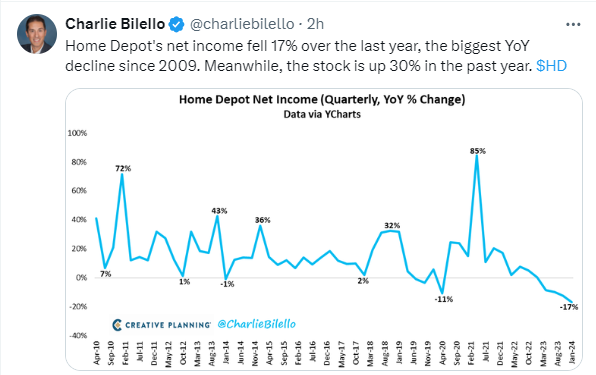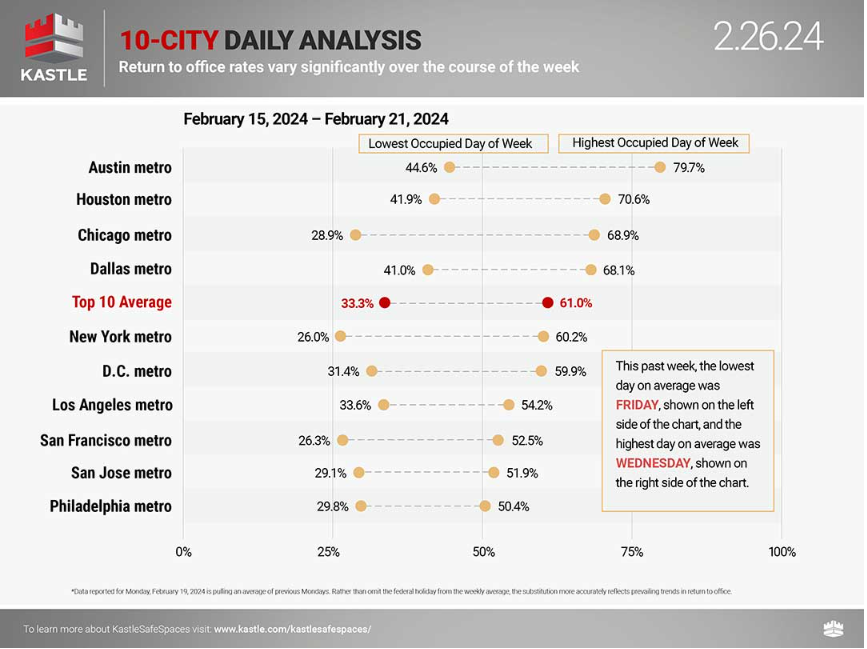1. History of Median P/E Ratios
From Irrelevant Investor Blog

Animal Spirits: Now Show Japan
2. 2-Year Treasury …4 to 4.70 in 2024
Not sure how much moving averages matter in bonds…but 2-year about to close over 200day

3. Home Depot Big Decline in Income

Stock making run at all-time highs above $400

4. U.S. Mag 7 Concentrated Rally…We Showed Europe Top 25 Concentrated Rally…..Japan Also Concentrated Rally
Torsten Slok, Ph.D.-Chief Economist, Partner

5. Beyond Meats Hit a High of $250 in 2019
BYND +40% yesterday but….

6. As Bitcoin Makes Run at Highs….COINBASE +53% in One Month

7. $1B Paid to Hackers Last Year thru Crypto
The Daily Shot Brief Food for Thought: Total crypto payments to hackers:

Source: @axios
8. 10 Largest Cities Back to the Office…Austin #1 vs. Philly #10
Kastle Systems

Kastle Systems – Data Assisting in Return to Office Plans
9. The greenest car in America isn’t an EV
Story by Shannon Osaka Washington Post If you try to imagine a “green” car, an EV is probably the first thing that comes to mind. A silent motor with tons of torque; no fumes, gasoline smells, or air pollution belching from an exhaust pipe. Last year, U.S. consumers had over 50 electric car models to choose from, up from about 30 the year before.
But a new report from the American Council for an Energy Efficient Economy suggests that the “greenest” car in America may not be fully electric. The nonprofit group, which has rated the pollution from vehicles for decades, says the winning car this year is the Toyota Prius Prime, a plug-in hybrid that can go 48 miles on electricity before switching to hybrid.
“It’s the shape of the body, the technology within it, and the overall weight,” said Peter Huether, senior research associate for transportation at ACEEE. “And all different types of Priuses are very efficient.”
It’s not the first time that a plug-in vehicle has topped the GreenerCars list; the Prius Prime also won out in 2020 and 2022. But with more and more electric vehicles on the market, the staying power of the plug-in hybrid is surprising.
https://www.msn.com/en-us/autos/news/the-greenest-car-in-america-isn-t-an-ev/ar-BB1j2nwl
10. Peter Diamandis Predicts ‘Millions, Then Billions’ of Humanoid Robots Are Coming
INC BY CHLOE AIELLO, REPORTER@CHLOBO_ILO
Robot people aren’t just for science fiction movies anymore.
XPrize Foundation founder Peter Diamandis predicts that millions or even billions of robots that look and move like people could integrate into consumers’ homes and workplaces, thanks to technological breakthroughs including artificial intelligence and a looming labor shortage. The market for these robots could hit $150 billion by 2035 and as much as $3 trillion by 2050, according to figures cited by Diamandis.
“It’s only now, driven by major advances in sensors and actuators, battery technologies and artificial intelligence, that a new generation of useful and affordable robotic labor is within reach,” Diamandis wrote in a recent blog post.
Recent advancements in generative AI, the technology that enables applications like ChatGPT, have taken the world by storm. Generative AI “magnifies a robot’s adaptability,” Diamandis wrote, by using “reinforcement learning” combined with decision-making algorithms. Plus, robots have the potential to instantaneously share learned skills with others in their network–something humans cannot do.
The market for these robots could be huge. In a 2022 report, Goldman Sachs predicted the market value of humanoid robots in a “blue sky scenario” could hit as much as $154 billion by 2035. Cathie Wood, founder and CEO of investment management firm Ark Invest, sets the bar even higher, at $1 trillion by 2030. Financial services company Macquarie, meanwhile, anticipates a whopping $3 trillion market for humanoid robots by 2050.
Diamandis extolled the utility of a humanoid robot laborer who “operates 24/7, who doesn’t need drug testing, and doesn’t call in sick from a fight with their boyfriend or girlfriend,” in a recent conversation with Inc.
Lidar, or light detection and ranging sensors, is the technology that gives sight to autonomous vehicles–and could do the same for humanoid robots. It works by rapidly firing a laser off of surrounding objects, and then using a sensor to measure the length of time it takes for the light to travel out and bounce back, according to the National Ecological Observatory Network. These measurements, used for mapping out surroundings, help robots navigate, according to San Jose, California-based lidar company Velodyne Lidar. The size and cost of lidar units have shrunk 1,000 times and 100 times, respectively, Diamandis writes, making the technology more accessible.
Driving the demand for humanoid robots is a looming labor shortage as Baby Boomers head into retirement with fewer young workers to replace them, Diamandis notes. This could be an advantage to workers as robots replace less desirable jobs in industries like manufacturing and agriculture. But more than industry is behind Macquarie’s massive market predictions. Wendy Pan, an analyst for Macquarie Research in Japan, sees humanoid robots as the next logical step in a long line of technological advances.
“The car helped shorten people’s commute time. I see the purpose as similar for humanoid robots: to shorten people’s time spent on housework, making people’s lives easier and more convenient,” writes Pan.
Diamandis isn’t alone in his sentiments. Microsoft co-founder Bill Gates and Tesla CEO Elon Musk are among the big names bullish about humanoid robots.
Peter Diamandis Predicts ‘Millions, Then Billions’ of Humanoid Robots Are Coming | Inc.com